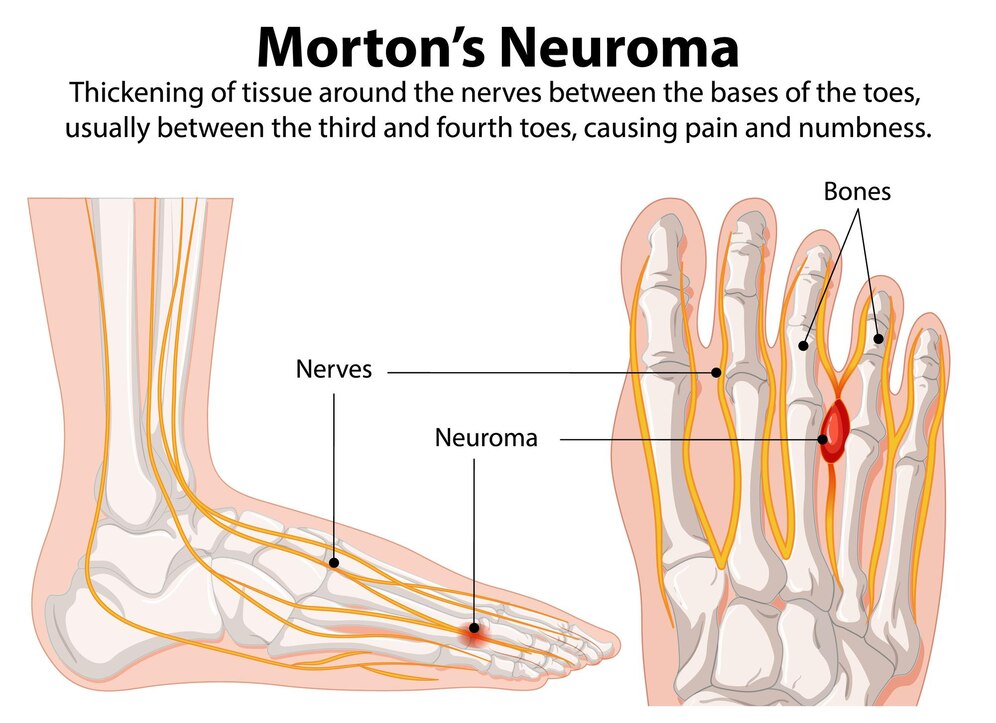Neuropathic pain differs from other pain types as it originates from nerve damage or dysfunction rather than tissue injury or inflammation. It can result from various conditions and significantly impact an individual's quality of life. Understanding the different types of neuropathic pain is crucial for effective management and treatment.
Types of Neuropathic Pain
-
Peripheral Neuropathy:
-
Definition: Damage to the peripheral nerves, which connect the brain and spinal cord to the rest of the body.
-
Causes: Diabetes, infections (such as shingles), traumatic injuries, and certain medications.
-
Symptoms: Tingling, burning, sharp pain, numbness, and sensitivity to touch.
-
-
Central Pain Syndrome:
-
Definition: Pain resulting from damage to the central nervous system (CNS), including the brain and spinal cord.
-
Causes: Stroke, multiple sclerosis, spinal cord injuries, and brain injuries.
-
Symptoms: Burning or aching pain, sensitivity to touch or temperature, and spontaneous pain without apparent cause.
-
-
Trigeminal Neuralgia:
-
Definition: Severe, sudden facial pain originating from the trigeminal nerve.
-
Causes: Blood vessel pressing on the trigeminal nerve, multiple sclerosis, or nerve damage.
-
Symptoms: Intense, electric-shock-like pain in the face, often triggered by mild stimulation such as eating or talking.
-
-
Postherpetic Neuralgia:
-
Definition: Pain that persists after a shingles infection has resolved.
-
Causes: Damage to the nerves caused by the varicella-zoster virus.
-
Symptoms: Burning, sharp pain, sensitivity to touch, and itching at the site of the previous shingles rash.
-
-
Phantom Limb Pain:
-
Definition: Pain felt in a limb that has been amputated.
-
Causes: The brain continues to receive signals from nerves that originally carried impulses from the missing limb.
-
Symptoms: Shooting, stabbing, or burning pain in the area where the limb used to be.
-
-
Diabetic Neuropathy:
-
Definition: A type of peripheral neuropathy specifically caused by diabetes.
-
Causes: High blood sugar levels leading to nerve damage.
-
Symptoms: Numbness, tingling, burning pain, and loss of sensation in the feet and hands.
-
Symptoms of Neuropathic Pain
-
Burning or Shooting Pain: Common in all types, often described as a sharp, jabbing, or electric-shock-like pain.
-
Tingling and Numbness: A prickling sensation or loss of feeling, especially in peripheral neuropathy.
-
Increased Sensitivity: Heightened sensitivity to pain (hyperalgesia) or normal touch (allodynia).
-
Spontaneous Pain: Pain that occurs without any apparent trigger.
Causes of Neuropathic Pain
-
Diabetes: Leading cause of peripheral neuropathy.
-
Infections: Such as shingles or HIV/AIDS.
-
Trauma: Injuries that damage nerves.
-
Multiple Sclerosis: CNS condition causing nerve damage.
-
Stroke: Can lead to central pain syndrome.
-
Cancer: Tumors pressing on nerves or cancer treatments.
Treatment Options
-
Medications:
-
Antidepressants: Tricyclic antidepressants (e.g., amitriptyline) and serotonin-norepinephrine reuptake inhibitors (SNRIs) (e.g., duloxetine) for pain relief.
-
Anticonvulsants: Medications like gabapentin and pregabalin to reduce nerve pain.
-
Topical Treatments: Creams or patches containing lidocaine or capsaicin for localized pain relief.
-
Pain Relievers: Over-the-counter and prescription painkillers, though opioids are typically not first-line treatments due to addiction risks.
-
-
Physical Therapy:
-
Exercises to strengthen muscles, improve mobility, and reduce pain.
-
-
Nerve Blocks and Injections:
-
Local anesthetics or steroids injected near the affected nerves.
-
-
Surgical Interventions:
-
Procedures to relieve pressure on nerves or correct underlying issues.
-
-
Alternative Therapies:
-
Acupuncture, chiropractic care, and biofeedback to manage symptoms.
-
-
Lifestyle Modifications:
-
Proper management of underlying conditions like diabetes, maintaining a healthy diet, and regular exercise.
-
Understanding the different types of neuropathic pain, their causes, and symptoms is essential for effective management. By recognizing the unique characteristics of each type, individuals can seek appropriate treatments and improve their quality of life. A combination of medical interventions, lifestyle changes, and alternative therapies can provide relief and help manage the complexities of neuropathic pain.




